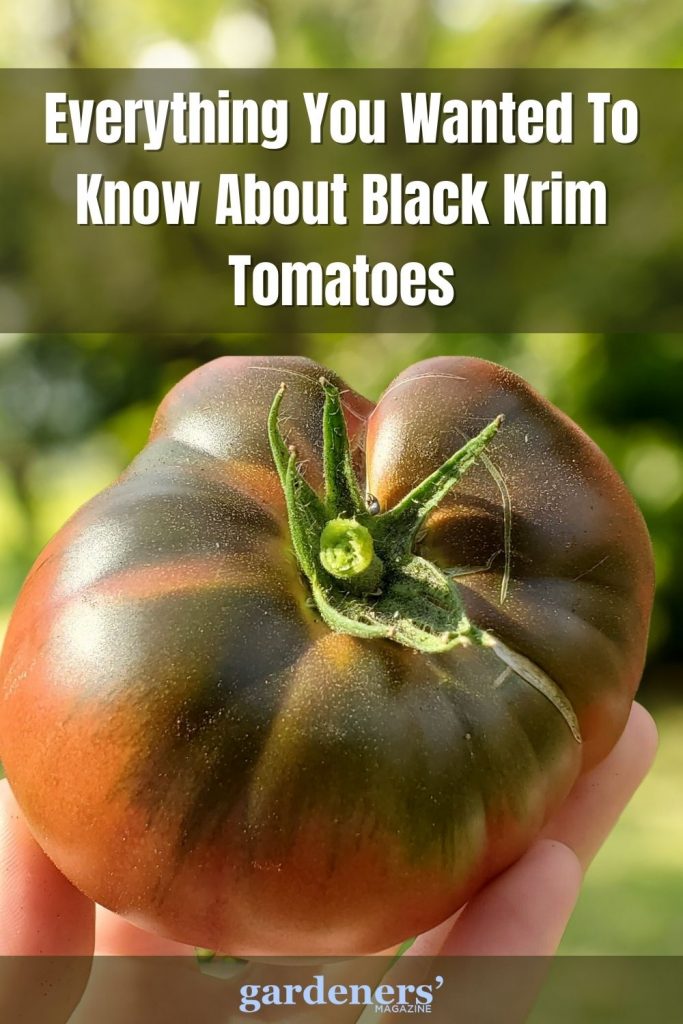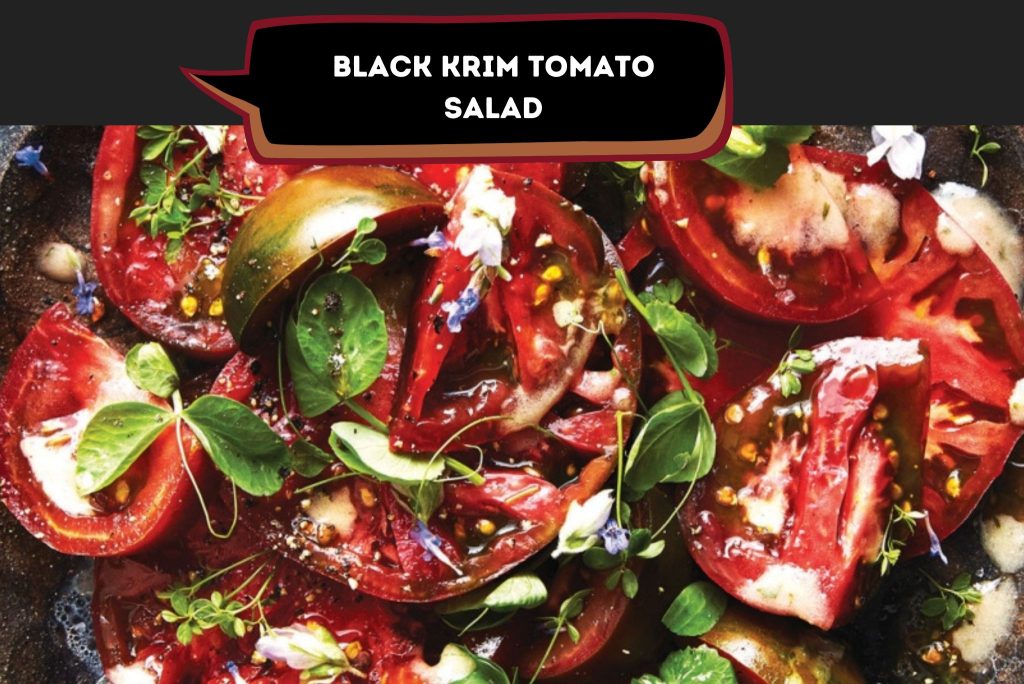Black Krim tomatoes are a unique and flavorful variety originating from the Black Sea region of Russia. They have a deep red color with purple tinges, a more concentrated flavor than other heirloom varieties, and are grown for their savory taste. If you want to grow your Black Krim tomato plants, read on for everything you need to know about caring for them.

What are Black Krim Tomatoes?
Black Krim tomatoes are a unique and flavorful heirloom tomato variety prized for their distinct characteristics. Scientifically known as Solanum lycopersicum ‘Black Krim’, these tomatoes are renowned for their rich, complex flavor and striking appearance. They typically have a deep, dusky purple-to-black color with green shoulders and a slightly flattened shape.
In terms of cultivation, Black Krim tomatoes are indeterminate, meaning they continue to grow and produce fruit throughout the growing season. They require full sun, well-drained soil, and regular watering to thrive. With proper care, these tomatoes can reach sizes of up to 12 ounces or more.
This variety of tomatoes is renowned for its tart, smoky flavor, which makes it perfect for salads, sandwiches, pastas, and more. It has an intense sweetness and umami-like quality from the higher levels of sugars and acids in the fruit. The dark skin is also rich in anthocyanins, a potent antioxidant that can help protect against certain types of cancers.
History and Origin of Black Krim Tomatoes
Black Krim tomatoes were first grown in the Black Sea Region of Russia and have been a part of Russian culture for hundreds of years. The name “Krim” is derived from the Crimean peninsula, which was once under the control of the Ottomans. It wasn’t until 1994 that this variety made its way to the United States by a seed company based in Michigan.
Since then, they have become popular among home gardeners and commercial farmers for their unique flavor and dark color. They are considered an heirloom variety because of their long history and genetic consistency from generation to generation.
Today, Black Krim tomatoes continue to captivate gardeners, chefs, and aficionados alike with their rich, multi-layered flavor and striking appearance. Their journey from the shores of the Black Sea to global recognition stands as a testament to their historical significance and culinary excellence.
Description of Black Krim Tomatoes
Black Krim tomatoes, scientifically known as Solanum lycopersicum ‘Black Krim’, are a distinctive heirloom tomato variety renowned for their unique appearance and exceptional flavor profile. These tomatoes typically exhibit a striking maroon or deep purple-to-black coloration with hints of green on the shoulders, giving them an eye-catching and intriguing aesthetic.
In terms of size and shape, Black Krim tomatoes often feature a slightly flattened or irregular form, adding to their visual appeal. They are typically medium to large, with some specimens reaching weights of up to 12 ounces or more.
Beyond their appearance, Black Krim tomatoes are celebrated for their rich, complex flavor. They are known for their deliciously smoky, sweet, and tangy taste, making them a favorite among tomato enthusiasts and culinary aficionados alike.
What is the Flavor Profile of Black Krim Tomatoes?
The flavor profile of Black Krim tomatoes is characterized by their rich, complex, and deeply satisfying taste. These tomatoes are renowned for their unique combination of smoky, sweet, and tangy flavors, which sets them apart from other tomato varieties.
When ripe, Black Krim tomatoes offer a delightful balance of sweetness and acidity, with a pronounced umami richness that adds depth and complexity to their taste. The smoky undertones, reminiscent of the sun-drenched soils of their native region, further enhance their flavor profile, providing a distinctive and memorable culinary experience.
Additionally, Black Krim tomatoes often exhibit a subtle earthiness and hints of saltiness, which contribute to their overall depth of flavor. The texture of these tomatoes is typically smooth and succulent, with a juicy interior that bursts with flavor with each bite.
Seasonality and Availability Throughout the Year of Black Krim Tomatoes
Black Krim tomatoes, like many other tomato varieties, are typically available during the warmer months of the year, specifically in late spring, summer, and early fall. Their seasonality aligns with the typical growing season for tomatoes in temperate climates.
In regions with mild winters or greenhouse cultivation, Black Krim tomatoes may be available earlier in the spring and later into the fall or even winter months. However, their peak availability is generally during the warmer months when outdoor conditions are optimal for tomato cultivation.
During their peak season, Black Krim tomatoes can be found at farmers’ markets, specialty grocery stores, and farm stands, as well as through community-supported agriculture (CSA) programs and direct sales from local growers. Additionally, they may be available in larger supermarkets that prioritize offering a variety of heirloom and specialty produce.
Outside of their peak season, Black Krim tomatoes may be more challenging to find fresh, but they may still be available in some markets that source produce from greenhouse growers or regions with extended growing seasons.
Overall, the seasonality and availability of Black Krim tomatoes are influenced by factors such as climate, growing practices, and regional agricultural trends. Still, they are generally most abundant and flavorful during the warmer months of the year.
Nutritional Benefits of Black Krim Tomatoes
Black Krim tomatoes offer a range of nutritional benefits that can contribute to overall health. They are rich in essential vitamins and minerals such as vitamin C, vitamin K, potassium, and folate, supporting various bodily functions, including immunity and heart health. Additionally, Black Krim tomatoes contain antioxidants like lycopene, beta-carotene, and vitamin E, which help combat oxidative stress and reduce the risk of chronic diseases like cancer and heart disease.
With their high water content, Black Krim tomatoes contribute to hydration, aiding in maintaining fluid balance and hydration status. They also provide dietary fiber, promoting digestive health, regulating bowel movements, and aiding in weight management by inducing feelings of fullness. Being naturally low in calories, Black Krim tomatoes offer a nutritious option for individuals looking to manage their calorie intake while still enjoying flavorful foods.
Cultivation of the Black Krim Tomatoes
Black Krim tomatoes can be grown in containers and directly in the ground. When planting, keep a distance of about 45 cm (18 inches) between plants. The soil should be rich, with good drainage, preferably raised beds or planters lined with cardboard before filling them with potting soil or compost. Choose a sunny location with well-drained soil for planting Black Krim tomatoes.
Make sure to water regularly and deeply, as Black Krim tomatoes are quite sensitive to drought. Applying organic mulch around the plants is also important to keep the soil moist and free of weeds. For a better yield, removing all lateral shoots (suckers) from the main stem up until two weeks before harvesting is recommended.
When harvesting, Black Krim tomatoes should be picked when fruits are still a bit firm. The colors of the ripe tomatoes vary from dark red to almost black. They have an unusual taste with a hint of smokiness and sweetness.
Harvesting of the Black Krim Tomatoes
- Ripeness Indicators: Black Krim tomatoes are typically ready for harvest when they reach full maturity and develop their characteristic deep purple to black-color with green shoulders. They should also feel firm but give slightly when gently squeezed.
- Harvesting Technique: To harvest Black Krim tomatoes, use sharp scissors or pruning shears to cut the fruit from the vine, leaving a small portion of the stem attached. Avoid pulling or twisting the tomatoes, as this can damage the plant.
- Timing: Harvest Black Krim tomatoes when they are fully ripe but still firm to the touch. This ensures optimal flavor and texture. Depending on the climate and growing conditions, harvesting typically occurs in late summer to early fall, when the tomatoes have reached their peak ripeness.
- Frequency: Check Black Krim tomato plants regularly for ripe fruit, especially during periods of warm weather. Harvest ripe tomatoes as soon as they are ready to prevent overripening or spoilage, as they are prone to rot.

Where Do Black Krim Tomatoes Grow?
Black Krim tomatoes can be grown in various regions and climates, but they thrive best in locations with warm temperatures and ample sunlight. Originally cultivated in the Black Sea region of Russia, Black Krim tomatoes have adapted to a wide range of growing conditions and are now grown in many parts of the world.
In the United States, Black Krim tomatoes are commonly grown in regions with long, hot summers, such as the southern and western states. They perform well in USDA hardiness zones 5-11, where they can receive at least 6-8 hours of sunlight daily and have well-draining soil.
Gardeners in cooler climates can also grow Black Krim tomatoes successfully by starting them indoors early in the season and transplanting them once the threat of frost has passed. Additionally, greenhouse cultivation allows for year-round production of Black Krim tomatoes in regions with colder climates.
What are the Things to Remember When Buying Black Krim Tomatoes?
When buying Black Krim tomatoes, there are several things to keep in mind to ensure you select the best-quality fruit:
- Color: Look for Black Krim tomatoes that have a deep purple to black color with green shoulders. The color should be uniform and vibrant, indicating ripeness and flavor.
- Texture: Choose tomatoes that feel firm but give slightly when gently squeezed. Avoid tomatoes that are overly soft or mushy, as they may be overripe or starting to spoil.
- Fragrance: A ripe Black Krim tomato should have a sweet, earthy aroma. Sniff the stem end of the tomato to check for a pleasant scent, which indicates optimal ripeness.
- Weight: Heavier tomatoes typically indicate juiciness and denser flesh, which can contribute to better flavor and texture. Pick up a few tomatoes and compare their weights to choose the plumpest ones.
- Appearance: Inspect the tomatoes’ surfaces for blemishes, bruises, or signs of mold. Choose tomatoes that are smooth, glossy, and free from visible damage.
How Can Black Krim Tomatoes Be Used in Recipes With Other Fruits and Vegetables?
Black Krim tomatoes are versatile and flavorful ingredients that can be used in various recipes. These tomatoes pair well with other fruits and vegetables, such as onions, garlic, peppers, eggplants, squash, zucchini, spinach, broccoli, kale, and melons. They can also be used to create delicious salads with other types of tomatoes, such as cherry tomatoes, or to make sauces for pasta dishes.
Black Krim tomatoes can also be grilled or roasted for a smoky flavor and aroma that complements any meal. Try stuffing them with your favorite fillings before baking them in the oven for a creative twist.
No matter how you choose to use them, Black Krim tomatoes are sure to bring a unique and delicious flavor to any dish. With their rich, earthy taste, these tomatoes can bring a more complex flavor than other varieties.

Conclusion
In conclusion, Black Krim tomatoes stand out for their rich flavor and distinctive appearance. Originating from the Black Sea region of Russia, these heirloom tomatoes offer a unique combination of deep purple to black hues with green shoulders and a smoky, sweet, and tangy taste. They provide a wealth of nutritional benefits and are versatile in various culinary applications. So why wait? Start exploring the delicious possibilities that Black Krim tomatoes can bring to your table.
- Everything You Wanted to Know About Red Tamarillos - June 2, 2025
- A Guide to Tulips: Everything You Need to Know & More… - June 2, 2025
- Guanabana: Description, Flavor, Benefits, And Uses - May 27, 2025

1 thought on “Everything You Wanted to Know About Black Krim Tomatoes”
Comments are closed.